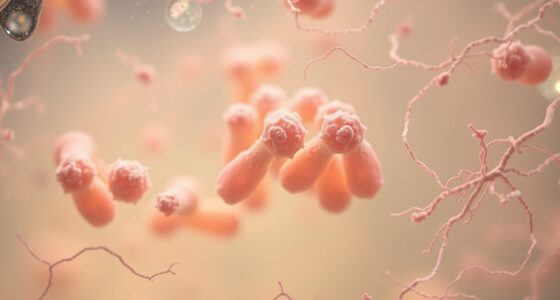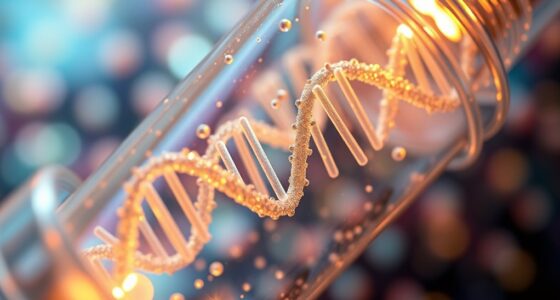The chemistry behind common painkillers shows how their molecular structures let them block pain signals or reduce inflammation. For example, NSAIDs like aspirin fit into enzymes called COX to prevent pro-inflammatory chemicals, easing pain. Their unique structures determine how long they last and how they interact with your body. Understanding these details can reveal surprising ways drugs work and how newer medicines are designed for greater safety—continue and discover how this chemistry truly shapes pain relief.
Key Takeaways
- Painkillers work by mimicking or blocking natural molecules, with their molecular structures determining target binding and effectiveness.
- NSAIDs inhibit enzymes like COX-1 and COX-2 to reduce prostaglandin production, alleviating pain and inflammation.
- Drug interactions depend on molecular structures competing for enzyme binding sites or affecting drug metabolism pathways.
- The specific molecular architecture influences how quickly a painkiller is metabolized, impacting its duration and potency.
- Advances in understanding molecular structures enable the design of safer, more effective pain medications with improved pharmacokinetics.

Painkillers, also known as analgesics, work by interacting with your body’s chemistry to block pain signals or reduce inflammation. At the core of how these medications function are their molecular structures, which determine how they fit into specific targets within your body. These structures are carefully designed to mimic or interfere with natural compounds, allowing the drugs to bind to enzymes or receptors involved in pain pathways.
Molecular structures of painkillers determine how they target pain pathways and interact with your body’s chemistry.
For example, many common painkillers like acetaminophen and NSAIDs are built with molecular structures that enable them to inhibit particular enzymes, such as cyclooxygenases (COX-1 and COX-2), reducing the production of prostaglandins that cause pain and swelling. Understanding these molecular structures helps chemists develop more effective drugs with fewer side effects by fine-tuning how they interact with their targets.
However, your body’s chemistry isn’t static, and drug interactions can complicate how painkillers work. When you take multiple medications, their molecular structures might interact in ways that alter their effectiveness or cause unwanted side effects. For instance, certain drugs can compete for the same enzyme binding sites, diminishing each other’s potency. Others might influence the enzymes responsible for metabolizing these medications, either speeding up or slowing down their breakdown.
This can lead to higher levels of the drug in your system, increasing the risk of toxicity, or lower levels, making the medication less effective. Being aware of these potential interactions is essential, especially if you’re on multiple prescriptions, as it can influence your pain management strategy.
The molecular structures of painkillers also play a role in how they’re metabolized and eliminated from your body, which affects their duration of action. For example, aspirin’s acetyl group allows it to irreversibly inhibit COX enzymes, providing longer-lasting pain relief but also increasing the risk of side effects like gastrointestinal irritation. Additionally, the specific molecular architecture of a drug influences how it interacts with enzymes involved in its metabolism, affecting its overall pharmacokinetics. Moreover, advancements in understanding drug design have led to the development of medications with optimized molecular structures to improve efficacy and safety profiles.
In contrast, drugs with different molecular architectures may be processed more quickly or slowly by your liver, impacting how often you need to take them. This highlights the importance of understanding the chemistry behind these drugs to optimize their use and minimize risks.
Frequently Asked Questions
Are All Painkillers Safe for Long-Term Use?
You might think all painkillers are safe for long-term use, but that’s not the case. While some, like acetaminophen, are generally safer, others, such as opioids, carry higher long-term risks and addiction potential.
It’s a fine line to walk, and you should always consult your doctor before using painkillers long term. Ignoring this advice could lead to serious health issues or dependency.
Stay cautious and informed.
How Do Natural Painkillers Compare Chemically to Synthetic Ones?
You might wonder how natural painkillers compare chemically to synthetic ones. Natural compounds, like willow bark or capsaicin, contain active ingredients that evolved naturally, often with fewer side effects.
Synthetic derivatives are created in labs, designed to enhance potency or reduce risks. While both can be effective, natural compounds tend to be milder, whereas synthetic ones are more potent but may carry higher risks of adverse effects.
Can Painkillers Cause Allergic Reactions at the Molecular Level?
Imagine molecules acting like tiny keys, fitting into your immune system’s locks. Painkillers can sometimes have molecular triggers that set off an immune response, causing allergic reactions.
When your immune system recognizes these molecules as threats, it releases chemicals like histamines, leading to symptoms like swelling, itching, or difficulty breathing.
What Role Do Enzymes Play in Painkiller Effectiveness?
You might wonder how enzymes influence painkiller effectiveness. Enzymes play a vital role by facilitating enzyme activation, which triggers metabolic pathways that process these drugs.
When your body efficiently activates enzymes, it breaks down painkillers more effectively, leading to better relief. Conversely, if enzyme activity is slow or impaired, the drugs may not work as well.
Understanding these processes helps explain why some people respond differently to pain medication.
How Does Individual Genetics Influence Painkiller Metabolism?
Your body’s response to painkillers is like a fingerprint—unique and influenced by genetic variations. These variations affect enzyme activity, which in turn determines how quickly your body metabolizes medications.
If your enzymes work faster, you might need higher doses; if slower, lower doses could be effective. Understanding your genetics can help tailor pain relief, making treatments more effective and reducing side effects.
Conclusion
Now, imagine the tiny molecules dancing through your bloodstream, quietly blocking pain signals like a skilled conductor guiding an orchestra. These painkillers aren’t just simple pills; they’re complex chemical symphonies working behind the scenes. As they glide through your body, they soothe and silence discomfort, turning chaos into calm. Next time you reach for one, remember the intricate chemistry at play—an invisible ballet that brings relief and restores harmony within.









